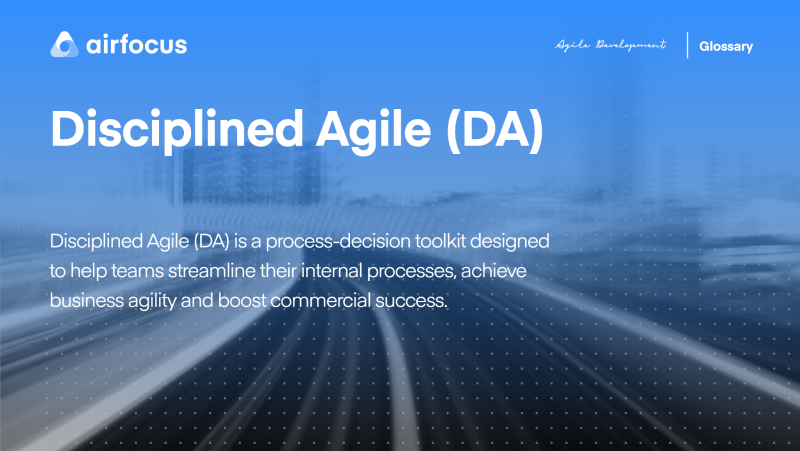Disciplined Agile (DA)
What is disciplined agile?
Definition of disciplined agile
Disciplined agile (DA) is a process-decision toolkit designed to help teams streamline their internal processes, achieve business agility and boost commercial success.
You may hear DA discussed alongside the crystal agile framework, scrum, eXtreme programming, or Kanban, and for good reason. The disciplined agile framework shares a lot of similarities with these other methodologies — in fact, you will come with the best elements of each within DA itself.
Some teams find the hybrid nature of disciplined agile difficult to handle, and it’s not recommended for teams who are new to agile ways of working to dive into DA right away.
However, if you’ve been working with agile for some time now, then DA could be a great next step.
By means of an introduction, here is the disciplined agile manifesto:
Individuals and interactions over processes and tools
Consumable solutions over comprehensive documentation
Stakeholder collaboration over contract negotiation
Responding to feedback over following a plan
Transparency over (false) predictability
The eagle-eyed among you may already be able to spot the similarities between this and the agile manifesto.
So what exactly does DA do for teams?
What is disciplined agile used for?
Following the disciplined agile manifesto, you will find the disciplined agile principles. There are seventeen principles in total, and these can be applied to a team’s working habits to:
Boost commercial success: DA helps the organization to become more competitive and increase customer satisfaction — as the fourth DA principle makes clear: “Stakeholders and developers must actively collaborate to deliver outcomes that will delight our organization’s customers.”
Create more effective ways of working: The twelfth DA principle states, “The team continuously reflects on how to become more effective, then experiments, learns, and adjusts its behavior accordingly.” Put simply, DA helps you identify what works best for you based on your current situation. Then, you can look to introduce new strategies to make the software development process even more successful.
Optimize workflow: DA encourages decision-making at an organizational level and helps you optimize the overall workflow in which you are involved in. More specifically, there’s an emphasis on visualizing workflows to ensure smooth delivery (as DA principle #14 suggests) as well as evolving the entire organization, not just siloed teams (DA principle #15).
Advantages of disciplined agile
Beyond the obvious benefits of business agility, DA can deliver a range of other more surprising advantages, including:
Empowering and engaging team members: DA promotes a goal-based strategy over the prescriptive procedure, meaning teams are empowered to choose their own ways of working — applying methods and frameworks which work for them. Whether it’s scrum or Kanban, the power to select the most convenient and powerful processes increases autonomy and engagement in teamwork.
Supporting all types of teams — not just product or software development: DA is a toolkit that carries relevance across the business. For example, it could be just as important for marketing to work collaboratively with customers. Indeed, marketing, sales, and even procurement teams can benefit from DA.
Improving market competitiveness: By using DA, the product teams can ensure customers are ‘delighted’ with the products they receive (remember the fourth DA principle?). The happier your customers, the more loyal they will become, and the more untouchable your organization will be for rival businesses.

General FAQ

Glossary categories
Experience the new way of doing product management

Experience the new way of doing product management








